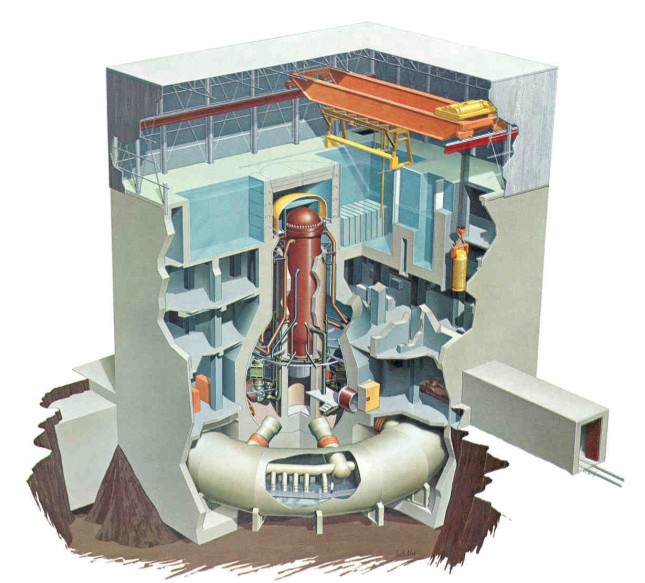
Cutaway diagram of the central reactor vessel and thick concrete containment in a typical boiling water reactor of the same era as Fukushima Daiichi 1
Posted on 03/12/2011 3:14:43 PM PST by Nobel_1
Three of Fukushima Daiichi's six reactors were in operation when yesterday's quake hit, at which point they shut down automatically and commenced removal of residual heat with the help of emergency diesel generators. These suddenly stopped about an hour later, and this has been put down to tsunami flooding by the International Atomic Energy Agency (IAEA).
The loss of the diesels led the plant owners Tokyo Electric Power Company (Tepco) to immediately notify the government of a technical emergency situation, which allows officials to take additional precautionary measures.
For many hours the primary focus of work at the site was to connect enough portable power modules to fully replace the diesels and enable the full operation of cooling systems.
(Excerpt) Read more at zerohedge.com ...
I recommend you read the commentary at Zero Hedge via the source URL, then check out the schematics at the above URL.
For comparison from NukeWorker.com
Re: Japan’s Nukes Following Earthquake
« Reply #81 on: Today at 11:39 »
Nuclear Renaissance (poster)
You get to primary containment flooding if you have no other reliable injection source to the vessel. Continued station blackout gets you most of the way there - an explosion in secondary containment does the rest.
Earthquake causes loss of grid
Loss of offsite power causes scram, Main Steam Isolation, and diesel generator start
Tsunami wave trips diesels an hour later – station blackout
Steam-driven systems are only means of injection – it is necessary to stay at pressure to maintain motive force
No AC means no containment cooling – HPCI should not be used due to its very high exhaust steam discharge into containment
Level is held low, in part to minimize injection (and resultant RCIC-exhaust containment heatup) and in part to stay on DC-powered level instruments
Containment venting becomes necessary to avoid overpressurizing containment – they probably were considering venting early with uncertainty of quake damage to containment
8 hr battery coping time is exceeded – RCIC becomes non-functional in auto
Local manual operation of RCIC becomes necessary (news reports said 4 operators were in the reactor building basement), meanwhile level continues to lower, challenging fuel
Hydrogen buildup in reactor building causes explosion, obliterating secondary containment and possibly damaging injection penetrations (most are AC-powered anyway). News reports said there were on Steam Condensing mode after the MSIV closure, which creates a direct vessel dome path to the RHR heat exchangers.
Enter containment flooding.
Bfl

Cutaway diagram of the central reactor vessel and thick concrete containment in a typical boiling water reactor of the same era as Fukushima Daiichi 1
Yah beat me.
One thing I don't get about it. Where are the control rods?
Re: Pressure and releases
quote from the article’s analysis:
“Without enough power for cooling systems, decay heat from the reactor cores of units 1, 2 and 3 has gradually reduced coolant water levels through evaporation. The consequent increase in pressure in the coolant circuit can be managed via pressure release valves. However, this leads to an increase in pressure within the reactor building containment. Tepco has said that the pressure within the containment of Fukushima Daiichi 1 has reached around 840 kPa, compared to reference levels of 400 kPa.”
(840 kPa is approx 122 psi)
Easy to see why the top blew off.. looks like its made not nearly as strong as the rest of the building.

Generic schematic for this reactor type

Re: Summary status of the reactors earlier today
Fukushima Daiichi Unit 1
- 439 MWe BWR, 1971
- Automatically shut down
- Water level decreasing
- Pressure release implemented
- Explosion observed
- Containment believed intact
- Seawater injection has started
- Radiation levels did not rise after explosion
Unit 2
- 760 MWe BWR, 1974
- Automatically shut down
- Water level lower but steady
- Preparations for pressure release
Unit 3
- 760 MWe BWR, 1976
- Automatically shut down
- Preparations for pressure release
Unit 4
- 760 MWe BWR, 1978
- Shut for periodic inspection
Unit 5
- 760 MWe BWR, 1978
- Shut for periodic inspection
Unit 6
- 1067 MWe BWR, 1979
- Shut for periodic inspection
Fukushima Daini Unit 1
- 1067 MWe BWR, 1982
- Automatically shut down
- Offsite power available
- Water level stable
- Preparations for pressure release
Unit 2
- 1067 MWe BWR, 1984
- Automatically shut down
- Offsite power available
- Water level stable
- Preparations for pressure release
Unit 3
- 1067 MWe BWR, 1985
- Automatically shut down
- Offsite power available
- Water level stable
- Preparations for pressure release
Unit 4
- 1067 MWe BWR, 1987
- Automatically shut down
- Offsite power available
- Water level stable
- Preparations for pressure release
nice illustration
Thanks for all the good posts. If I hear one more time this is worse than Chernobyl, I am going to go ludicrously super critical.
Disclaimer: Opinions posted on Free Republic are those of the individual posters and do not necessarily represent the opinion of Free Republic or its management. All materials posted herein are protected by copyright law and the exemption for fair use of copyrighted works.